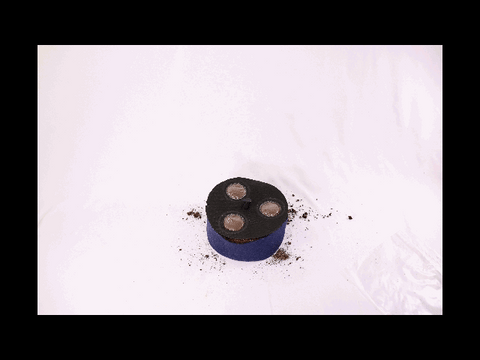One of the toughest parts of gardening is gauging how much water to give your plants. This is true of traditional gardening as well as gardening with a Seedsheet. Watering is one of the most critical factors in the success or failure of a garden. But never fear-- we’re here to make gardening ridiculously easy with these watering tips and tricks.

The first week to two week period of watering seeds is crucial to the germination process. Because there is only a thin layer of soil covering the seeds in a Seedsheet, it is very important that the initial watering is very gentle, so as not to disturb the seeds within the pods. Strong waterings can potentially result in seeds being washed out of the pod area and into the edges of the container where they will not germinate. Each Seedsheet comes with a green plastic watering nozzle, which can affix to any 1-liter plastic soda or water bottle with a standard screw-top. This watering nozzle will help to ensure that water is delivered in a gentle enough manner.
When watering your fresh Seedsheet pods, evenly spray each pod for about 15 seconds, then break for about 30 seconds, then water again for 15 seconds. Break and repeat this process until all of the pods have completely dissolved. The soil should appear completely saturated and the top and bottom film of the pod should have totally disappeared without displacing much of the soil covering the seeds. If a large amount of soil is displaced there is a potential that the seeds within the pod have been washed out as well, however, a small amount of soil displacement is normal.
Each subsequent daily watering should also be delivered with the same gentle, but thorough, touch. Here is a quick video on how to initially water the sheet so that you are not washing out the seeds:
During the germination process, it is extremely important that the soil surrounding the seeds remain moist. This moisture is like an “alarm bell” waking up the seeds to germinate. Some seed types are “lazy” and take longer than others to germinate and emerge above the soil surface. Be patient and these sprouts will come!
Check out the tutorial video below to see how to water your Seedsheet after the first watering to dissolving the pods:
On the flip side, if seeds sit in oversaturated soil for prolonged periods of time, they can rot and germination will not occur. The key to successful germination is appropriately damp soil which does not retain a large amount of water for more than an hour or two at most. Tips for avoiding overwatering:
- Take note of any excess water pooling underneath your garden into the saucer, plate, or tray underneath. If this occurs, remove the excess water and rein back on the quantity or frequency of watering. Standing water underneath your garden over a prolonged period of time can bring on the possibility of mold or algae development, which can ultimately result in poor germination or plant growth and development.
- Don’t be afraid to touch-test your soil for moisture content. Soil should feel damp, not muddy or powdery.
While Seedsheets make gardening ridiculously easy, every gardener from Maine to Hawaii has a unique environment with different external factors that influence the growth process in different ways. This means that we can only give general instructions for the recommended water quantity and frequency. For instance, in places like the desert of Arizona (where humidity is very low), soil will dry out faster, so more water may be necessary than what is recommended in the instructions below. On the other hand, in places with a much more humid climate (like the glades of Florida), you may have to water a bit less frequently and/or with less quantity, than the instructions below indicate.
Watering Quantities for Container Balcony Gardens:
Generally, for the first three weeks, we recommend applying about ½ of a liter of water daily. For the following three weeks, increasing water to ⅔ of a liter per day. Beyond the first six weeks, the plants will require an increase to 1 full liter of water per day. If rainfall occurs, the soil should be checked and watered if necessary. However, if the temperatures hover in the 80s and above, increased water quantity and/or frequency is recommended. Twice daily watering may be necessary; once in the morning before the sun becomes intense, then checking again in the late afternoon once the sun’s intensity has subsided (after 5 pm).
Watering Quantities for Mini Sheets:
Typically, for the first month, we recommend using about ¼ to ⅓ of a liter of water daily. After the first month, the plants will need an increase of water to about ½ liter per day. Be aware that soil will dry out faster on days when the air is dry and the temperatures are high. We recommend watering each morning with the above amounts, then checking on the garden in the evening to ensure the soil has not dried out since the morning watering. If the soil is very dry and powdery, a second evening watering is recommended. As foliage matures, the garden will require increasing amounts of water and/or increasing frequency of watering.
Watering young seedlings must be done so delicately to avoid crushing them with the weight of a strong watering. To avoid damaging the seedlings, water using the green watering nozzle, at an angle, towards the base of the seedlings at the soil surface. Avoid watering from directly overhead.
Our Customer Support Team is standing by if you ever have any questions about caring for your Seedsheet garden.




Comments (36)
3 are now sprouting after 5 days, I’m watering every day and have put the plants outside on my patio. Here in Florida it is very hot & humid, I hope they like that. I have the herb seedsheet.
Hi Claire,
Sounds like you are doing the right thing. It can be tough keeping things alive in conditions like that. However, I would suggest that you follow along with the suggested planting times on the packaging. Where you are, you actually will have two planting seasons; one, from the beginning of march to the end of May and the second is, the beginning of September to the end of November. Let us know if you have any other questions.
Happy Growing!
Paula,
It would depend on what variety of sheet that you have because certain plants are really quick to germinate, while others can take up to two weeks. In our Salad and Taco varieties, you should start to see sprouts within 3-4 days, which are the quickest to germ. The slowest to germ are some of the herbs like parsley and some of the basil varieties, and then also the fruiting vegetables like tomatoes and peppers. Like I said these can take up to two weeks before they start to sprout. Make sure you are keeping the soil moist throughout the germination process because the seeds need to be in constant contact with water in order to germinate. Let us know if you have any other questions.
Happy Gardening!
That’s awesome to hear Wolfgang! Keep up the good work and I am sure that the rest won’t be too far behind!
Happy Gardening!
2 of the 6 started to sprout
Leave a Comment